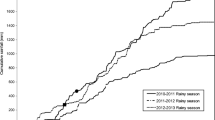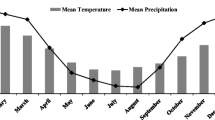Abstract
Crop and tree roots are crucial in the nutrient recycling hypotheses related to alley cropping systems. At the same time, they are the least understood components of these systems. The biomass, total N content and urea-derived N content of the Senna and maize roots in a Senna-maize alley cropping system were followed for a period of 1.5 years (1 maize-cowpea rotation followed by 1 maize season) to a depth of 90 cm, after the application of 15N labeled urea. The highest maize root biomass was found in the 0–10 cm layer and this biomass peaked at 38 and 67 days after planting the 1994 maize (DAP) between the maize rows (112 kg ha−1, on average) and at 38, 67 and 107 DAP under the maize plants (4101 kg ha−1, on average). Almost no maize roots were found below 60 cm at any sampling date. Senna root biomass decreased with time in all soil layers (from 512 to 68 kg ha−1 for the 0–10 cm layer between 0 and 480 DAP). Below 10 cm, at least 62% of the total root biomass consisted of Senna roots and this value increased to 87% between 60 and 90 cm. Although these observations support the existence of a Senna root `safety net' between the alleys which could reduce nutrient leaching losses, the depth of such a net may be limited as the root biomass of the Senna trees in the 60–90 cm layer was below 100 kg ha−1, equivalent to a root length density of only < 0.05 cm cm−3. The proportion of maize root N derived from the applied urea (%Ndfu) decreased significantly with time (from 21% at 21 DAP to 8% at 107 DAP), while %Ndfu of the maize roots at the second harvest (480 DAP) was only 0.6%. The %Ndfu of the Senna roots never exceeded 4% at any depth or sampling time, but decreased less rapidly compared to the %Ndfu of the maize roots. The higher %Ndfu of the maize roots indicates that maize is more efficient in retrieving urea-derived N. The differences in dynamics of the %Ndfu also indicate that the turnover of N through the maize roots is much faster than the turnover of N through the Senna roots. The recovery of applied urea-N by the maize roots was highest in the top 0–10 cm of soil and never exceeded 0.4% (at 38 DAP) between the rows and 7.1% (at 67 DAP) under the rows. Total urea N recovery by the maize roots increased from 1.8 to 3.2% during the 1994 maize season, while the Senna roots never recovered more than 0.8% of the applied urea-N at any time during the experimental period. These values are low and signify that the roots of both plants will only marginally affect the total recovery of the applied urea-N. Measurement of the dynamics of the biomass and N content of the maize and Senna roots helps to explain the observed recovery of applied urea-N in the aboveground compartments of the alley cropping system.
Similar content being viewed by others
References
Aihou K, Sanginga N, Vanlauwe B, Lyasse O, Diels J and Merckx R 1999 Alley cropping in the moist savanna of West-Africa: I. Restoration and maintenance of soil fertility on ‘terre de barre’ soils in Bénin Republic. Agrof. Syst. 42,213–227.
Akinnifesi F K, Kang B T and Tijani-Eniola H 1995 Root-soil interface in agroforestry systems.In Rehabilitation and Management of African Soils for Sustainable Productivity and Environmental Protection. Ed. AA Agboola. pp 209–218. Proceedings of the third African Soil Science Society Conference, 21–26 August 1995, Ibadan, Nigeria.Organization of African Unity, Scientific Technical and Research Commission, Lagos, Nigeria.
FAO 1991 World Soil Resources: An Explanatory Note on the FAO World Soil Resources Map at 1:25 000 000 Scale.Food and Agriculture Organization of the United Nations, Rome, Italy. 58 p.
Hauser S 1993 Root distribution of Dactyladenia (Acioa) barteri and Senna (Cassia) siamea in alley cropping on Ultisol. I. Implication for field experimentation.Agrof. Syst.24, 111–121.
Kang B T 1994 Alley cropping – soil productivity and nutrient recycling. In Agroforestry and Land Use Change in Industrialized Nations Ed. R F Hüttl. pp 575–592.Proceedings of the 7th International Symposium of CIEC, Berlin. Goltze-Druck, Goettingen, Germany.
Marschner H 1986 Mineral Nutrition in Higher Plants.Academic Press Inc (London) Ltd, London, UK. 674 p.
Ruhigwa B A, Gichuru M P, Mambani B and Tariah N M 1992 Root distribution of Acioa barteri, Alchornea cordifolia, Cassia siamea and Gmelina arborea in an acid Ultisol.Agrof. Syst.19, 67–78.
SAS 1992 The MIXED procedure. In SAS Technical Report P-229: SAS/STAT Software: Changes and Enhancements. pp 287–366. SAS Institute Inc., Cary, NC, USA.
Smucker A JM, Ellis B G and Kang B T 1995 Alley cropping on an Alfisol in the forest savanna transition zone: root, nutrient, and water dynamics. In Alley Farming Research and Development. Eds. B T Kang, A Larbi and A O Osiname. pp 103–121. IITA Ibadan, Nigeria.
Tossah B K, Zamba D K, Vanlauwe B, Sanginga N, Lyasse O, Diels J and Merckx R 1999Alley cropping in the moist savanna zone of West-Africa: II. Impact on soil productivity on a North-to-South transect in Togo.Agrof. Syst.42,229–244.
Van Noordwijk M 1989 Rooting depth in cropping systems in the humid tropics in relation to nutrient use efficiency. In Nutrient Management for Food Crop Production in Tropical Farming Systems. Ed. J van den Heite. pp 129–144. Institute for Soil Fertility, Haren, The Netherlands.
Vanlauwe B, Nwoke O C, Sanginga N and Merckx R 1996 Impact of residue quality on the C and N mineralization of leaf and root residues of three agroforestry species. Plant Soil183,221–231.
Vanlauwe B, Sanginga N and Merckx R 2001a Alley cropping with Senna siamea in South-western Nigeria: I. Recovery of 15N labeled urea by the alley cropping system. Plant Soil,231, 187–199.
Vanlauwe B, Akinnifesi F K, Tossah B T, Lyasse O, Sanginga N and Merckx R 2001b Root distribution of Senna siamea, grown on a series of soils representative for the derived savanna zone in Togo, West Africa.Agroforestry Systems, in press.
Author information
Authors and Affiliations
Rights and permissions
About this article
Cite this article
Vanlauwe, B., Sanginga, N. & Merckx, R. Alley cropping with Senna siamea in South-western Nigeria: II. Dry matter, total N, and urea-derived N dynamics of the Senna and maize roots. Plant and Soil 231, 201–210 (2001). https://doi.org/10.1023/A:1010365529073
Issue Date:
DOI: https://doi.org/10.1023/A:1010365529073




